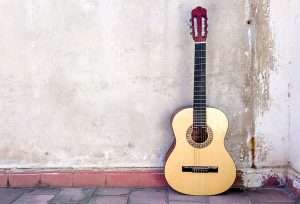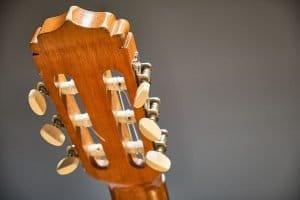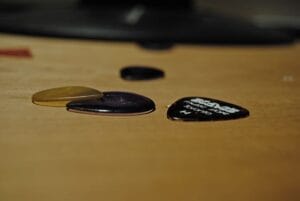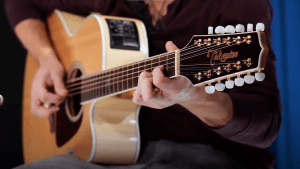Table of Contents
Most Useful Unique Guitar Accessories
Music is a creative expression, and there’s no better way to truly express yourself than by customizing your guitar. This is where unique guitar accessories come in.
Whether you’re looking for guitar gifts for men or enriching your collection, join us as we delve into the world of unique guitar accessories, where functionality meets creativity. Every piece tells a story of musical exploration.
Before continuing the list, don’t forget to check out the list of classical guitar supports you need.
Guitar Cases/Gig Bags
This item on our list is to keep your favorite guitar safe. A guitar case is a crucial accessory. They are designed to safeguard your guitar from the elements, impacts, and other potential hazards during travel or storage.
Modern cases come in various styles and materials, including rugged hard-shell cases and lightweight padded gig bags.
Gig Bag
Gig bags are typically constructed from softer, padded materials such as nylon, canvas, or other durable fabrics. They offer less protection compared to rigid hard-shell cases.
Find our list of high-quality guitar cases and gig bags.
But they’re a lightweight and convenient means of transporting a guitar. They offer protection against everyday bumps, scratches, and minor impacts. A guitar bag is a cheap and easy method of protecting the damage to the instrument. Since the Gig bag is cheap, it’s a good choice for guitar beginners.
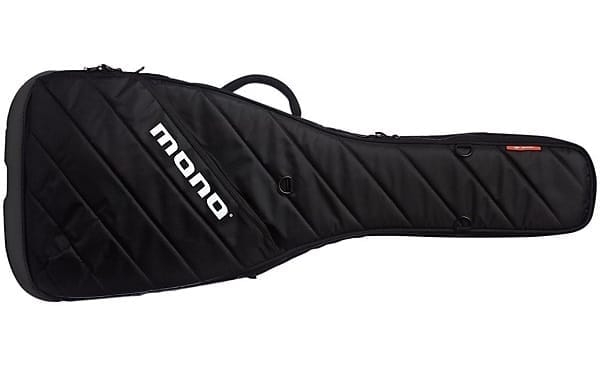
Though gig bags were once considered a low-cost option offering minimal protection, their quality has improved significantly over the years.
Now, there are both lightweight options for the budget-conscious and high-end gig bags with excellent protection for those who want convenience without sacrificing safety.
Guitar Case
The classic hardshell guitar case is designed to protect against bumps, dings, and even changes in environmental conditions.
These cases are often fortified with plush padding and rugged exteriors in various shapes, sizes, and materials. They’re usually constructed with sturdy materials like ABS plastic, plywood, or reinforced fabric. Different types of cases for acoustic and electric guitars are also available.
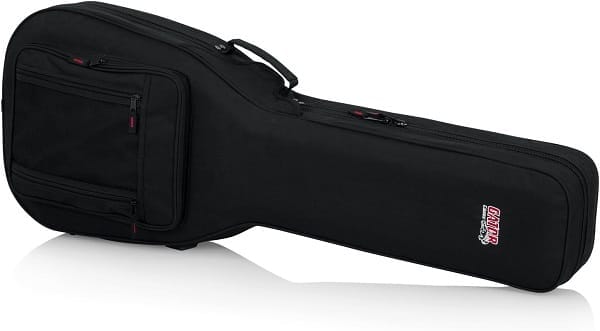
Hardshell cases typically feature reliable locking mechanisms and plush, thick padding. Because of their rigidity and structural integrity, any guitar player can transport their guitar without fear of damage.
Guitar Tuner
One of the most widely used unique guitar accessories, a guitar tuner is a tool for keeping your instrument in tune. It detects the frequency of each string’s vibrations and provides visual or audible feedback to indicate whether the string is too high, too low, or perfectly in tune.
Modern tuners often come with various tuning modes, accommodating different tuning standards and alternate tunings. Some tuners even incorporate features like metronomes and advanced tuning algorithms.
Clip-on Tuner

Some types of guitar tuners are made to attach directly to the guitar’s headstock with a clip. These sensors utilize vibration sensors to detect the instrument’s pitch. This usually makes them more accurate than standalone tuners, as this method removes interference from outside noise.
This is especially true in noisy environments like a live performance. Clip-on tuners are also highly portable and convenient for musicians on the move. Their hands-free operation allows for easy tuning on the go.
Pedal tuners
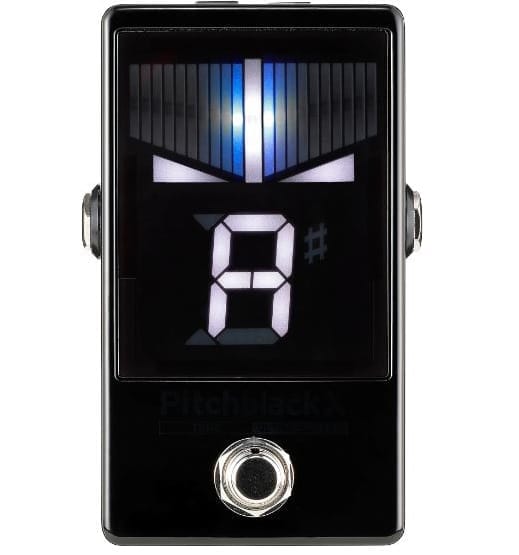
A pedal tuner is designed as a stompbox that integrates seamlessly into a guitarist’s pedalboard setup. One of the primary advantages of a pedal tuner is its ability to provide accurate tuning in real-time during live performances.
Its large, easily readable display and intuitive controls allow musicians to assess their instrument’s tuning status with a glance quickly.
A key feature of pedal tuners is their true-bypass functionality. This means that when the tuner is engaged, it routes the guitar’s signal directly to the tuner circuit by passing all other effects pedals.
This ensures the tuner has a clean and unaltered signal, resulting in highly accurate tuning readings. In some cases, this can also allow for silent tuning.
Guitar Picks
Guitar picks, or plectrums, are deceptively simple yet indispensable tools for guitarists. Picks are made of various high-quality materials, from plastic, nylon, and metal to organic substances like bone or wood. Also, it’s one of the essential gadgets for strumming guitar chords and notes on your guitar.
Guitar picks are among the more unique guitar accessories. The pick choice is highly personal, and guitarists often experiment with different picks to find the perfect match for their playing experience.

Types of picks
The shape and thickness of a pick can significantly affect the tone of a guitar.
Thin picks
Think picks produce a brighter, softer tone and are favored for strumming and rhythm playing.
Thick picks
Thick picks provide a crisper attack and are preferred for lead playing, allowing for precision and control.
Round-edge picks
Picks with a rounded edge produce a smooth, even tone.
Pointed-tip picks
Picks with a pointed tip deliver a sharper attack.
Specialized picks, like fingerpicks or thumbpicks, cater to fingerstyle players. They are commonly used in folk, bluegrass, and classical music genres. Check out our article on unique guitar picks here.
Guitar Pedal
A guitar pedal is one way musicians sculpt and enhance their sound. It works by manipulating the guitar’s signal before it reaches the amplifier. Guitar pedals are activated by footswitches, allowing for hands-free operation during live performances.
Pedals often feature adjustable parameters, allowing precise control over the effect’s intensity, speed, or depth. Some advanced pedals incorporate digital technology for even greater flexibility and a wide array of presets.
The versatility of pedals lies in their ability to be chained together. This allows musicians to create complex and personalized sonic landscapes. Appropriately used, artists can craft unique tones and experiment with various sonic textures to find their signature sound.
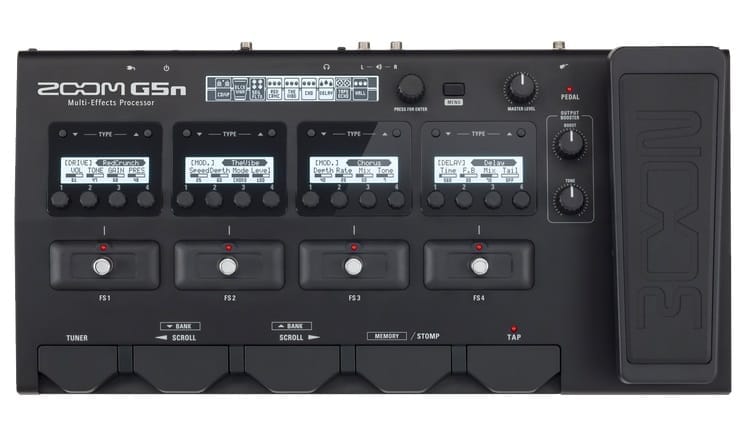
Types of Guitar Pedals
Generally, there are two categories of guitar pedals based on how they work.
Analog Pedal
An analog pedal passes a guitar’s electrical signal through transistors, resistors, capacitors, diodes, and more, depending on the sound the pedal is trying to produce.
Digital Pedal
A digital pedal picks up the guitar’s electrical signal, sampling and converting it into binary code before altering it using an effects algorithm. After that, it’s converted back to an electrical signal and sent on.
When divided based on what they do, though, guitar pedals come in a diverse range. Of the most commonly used ones, distortion and overdrive pedals add gain and saturation, creating a gritty, crunchy, or full-bodied tone.
Modulation pedals such as chorus, phaser, and flanger alter the waveform to produce swirling, wavy, or pulsating sounds. Delay and reverb pedals introduce time-based effects, creating echoes and ambient atmospheres.
These options make the guitar pedal the most versatile unique guitar accessories.
Guitar Amp
A guitar amp, short for an amplifier, is essential for guitars, acoustics, and electrics. It serves as the intermediary between the guitar and the speakers, enhancing and projecting the sound of your instrument.
The amp is the second-most necessary of the unique guitar accessories. These electronic devices come in various types, each offering distinct tonal characteristics and features. Connect the amp with the guitar’s output jack and check the sound of your guitar.

Selecting the right amp involves considering playing style, venue size, and personal tonal preferences. Amp power determines the volume level an amplifier can achieve. Lower-wattage amps are suitable for practice or studio settings, while higher-wattage amps are better for live performances.
Some amps have built-in effects such as reverb, chorus, and distortion. They can also have EQ controls, allowing for quick, on-the-spot tone balancing.
Types of Guitar Amps
Tube amplifiers
Tube amps are revered for their warm, organic tones. They utilize vacuum tubes to amplify the signal. Many favored them for their natural overdrive when pushed to higher volumes.
Solid-state amps
Conversely, these rely on transistors for amplification, providing a reliable and clean sound. They’re often chosen for their durability and consistent performance.
Digital amps
Digital amps employ advanced modeling technology to replicate the sounds and effects of various classic amplifiers. They offer versatility and a wide range of tonal options, making them popular for modern musicians seeking flexibility in their sound.
Guitar Strap
Whether in front of a live audience or practice with the company of none but yourself, a guitar strap is a must-have for anyone looking to perform. Typically made from leather, nylon, or suede, they come in various widths, designs, and lengths to accommodate different playing styles and body sizes. You can also personalized guitar straps that show your style.
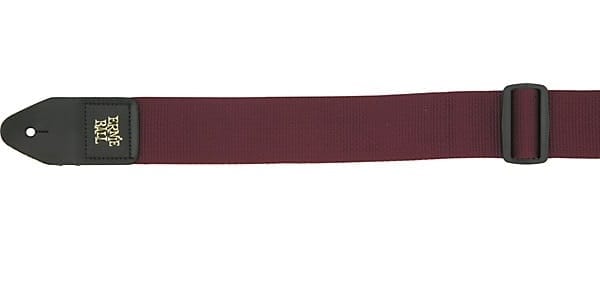
Comfort is paramount for any guitarist, and a well-chosen strap evenly distributes the guitar’s weight, preventing shoulder and neck strain during extended playing sessions.
Some straps, like Ernie Ball’s, come equipped with additional features, like padding, for extra comfort. They also feature locking mechanisms for secure attachment. Some even have pockets for storing picks, slides, or small accessories.
Beyond functionality, guitar straps are a canvas for personal expression. Intricate designs, patterns, and colors allow musicians to showcase their individuality and personality.
There’s a strap to suit every taste. You can personalize it in many ways to make your strap a unique guitar accessory that’s perfect for you.
Check out some unique guitar straps here; you might find something exciting.
Guitar Strap Accessories
Certain unique guitar accessories work with or help elevate the form and function of your guitar strap. While not as necessary as the strap, these guitar strap accessories are small additions that can make a significant difference for the exemplary guitarist.
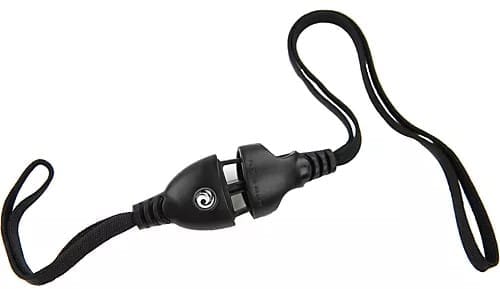
Strap Locks
We’ve all seen videos of guitars flying out after a guitarist tries swinging them around their necks. Strap locks are designed to solve that problem. These locks have two main parts: a strap button and a corresponding locking mechanism.
The strap button replaces the standard strap buttons on the guitar. The locking mechanism, typically a metal ring or clip, securely fastens onto the strap, creating a secure connection that prevents accidental disconnections during play.
Strap Extenders
Sometimes the strap you have in mind isn’t long enough for your needs. That’s where strap extenders come in. These handy tools are designed to lengthen the reach of a guitar strap by attaching it to the existing strap. This suits players who prefer to wear their instruments lower or have larger frames.
Strap extenders are made of various materials, including leather, nylon, and synthetic fabrics, ensuring durability and reliability. They are often adjustable, allowing a customizable fit to suit individual playing guitar styles and body types.
Strap Pads
Guitar straps can be rough on the shoulders—even a padded one can be uncomfortable because they rub against your shoulder during performance. In those cases, these shoulder-strap pads can provide some much-needed relief.
They come in two varieties: foam and gel. One advantage of these is that they’re easily swappable between straps, which is helpful for those with multiple guitars.
Guitar Strings
Guitar strings dictate the quality, tone, and playability of the sound produced. Unlike nylon string classical guitars, strings are generally composed of steel, nickel, bronze, or other alloys. They also come in various gauges, influencing the instrument’s feel and timbre.
Strings are THE most necessary out of the unique guitar accessories available – you can’t play a guitar without them. Experimenting with different string types and gauges is key to discovering the ideal combination that complements your playing style and genre. Investing in decent strings is vital if you want your guitar to sound its best.
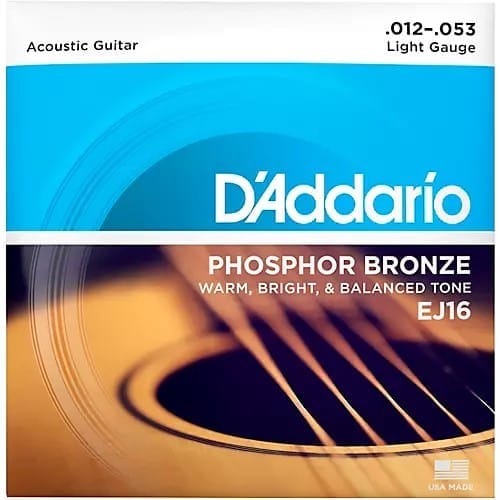
Types of Guitar Strings
Guitar strings come in a variety of types, each appropriate for certain types of guitars and playstyles.
Nylon Strings
These strings, typically found on classical guitars, are made of nylon or similar synthetic materials. They offer a warm, mellow tone and are favored for classical, flamenco, and finger-playing styles.
Know more about guitar fingerstyle; it’s a way to improve your skills
Steel Strings
Steel strings, made of steel or nickel alloys, are popular in acoustic and electric guitars. They produce bright, clear tones and are favored for rock, country, and pop genres.
Nickel guitar strings
Also known as nickel-wound strings, these are a popular choice for electric guitars. They are constructed using a steel core wire wrapped with a nickel alloy wire. This winding process gives the strings their characteristic bright and balanced tone.
Phosphor Bronze Strings
Phosphor bronze strings are commonly used in acoustic guitars. They have a bronze alloy core with phosphor added for enhanced warmth and longevity. They produce a balanced tone and are prevalent in folk, bluegrass, and country music.
Bronze Strings
Like phosphor bronze, bronze strings are made of copper and zinc alloy. They provide a bright, clear tone, making them suitable for various musical styles.
Flatwound Strings
These strings have a smooth, flat winding, which creates a warm, soft tone. They are popular in jazz and are known for their comfortable feel under the fingers.
Roundwound Strings
This is the most common type of electric guitar string. Due to the round winding wire, round-wound strings have a textured surface and provide a bright and articulate tone.
Halfwound (or Groundwound) Strings
These strings are a hybrid between flat wound and round wound, offering a compromise between warmth and brightness.
Coated Strings
Coated strings have a protective layer, often made of polymer or other materials, to extend their lifespan and maintain their tone for longer.
String Winders
Guitar string winders are invaluable tools for any guitarist, whether a seasoned professional or a budding enthusiast.
Every guitarist knows that strings wear out over time – even more if heavily used. As a result, guitar strings have to be changed regularly. T
These compact devices are designed to facilitate changing guitar strings, making it quicker, easier, and more efficient.
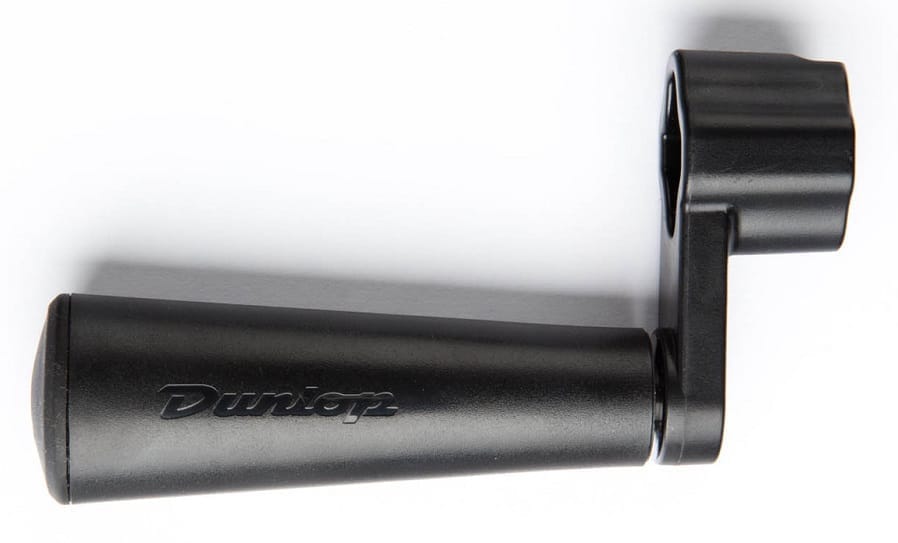
String winders come in various designs, including manual and electric models. Manual winders are hand-operated, requiring a few turns to tighten or loosen a string fully. Electric winders, on the other hand, are motorized and provide rapid, effortless string winding with the press of a button.
String winders are versatile and compatible with various types and sizes of tuning pegs.
Pick Holder
A pick holder is a small yet invaluable accessory for any guitar lover. It is one of the less-used unique guitar accessories and also an incredible gift for guitar players.
It provides a convenient and secure way to store and access guitar picks during play. This eliminates the need to fumble around for a pick mid-performance.
These guitar pick holders come in various designs and can be attached to the instrument, a strap, or even clothing or with a pick holder keychain.

Types of pick holders
A common type of pick holder is the adhesive-backed variety. This type typically consists of a minor, flat piece of material with an adhesive side that can be affixed to any surface.
Magnetic pick holders also exist. They use powerful magnets to keep picks in place and are usually attached to the back of a guitar’s headstock or a microphone stand.
Some pick holders are designed to be worn on a guitar strap. Other pick holders come in keychains, bracelets, or even rings. This offers a stylish and portable way to carry picks wherever you go.
With so many options you can choose from, this is a good option for a unique guitar accessory.
Guitar Stand
A guitar stand, also known as a guitar rack, is a simple accessory that keeps your guitar safe and provides a convenient resting place for the instrument when not used. It also keeps the guitar easily accessible for performances or simply playing the guitar at any time.
Designed with a stable base and supportive arms, a guitar stand cradles the instrument securely, preventing it from accidentally falling or getting knocked over.
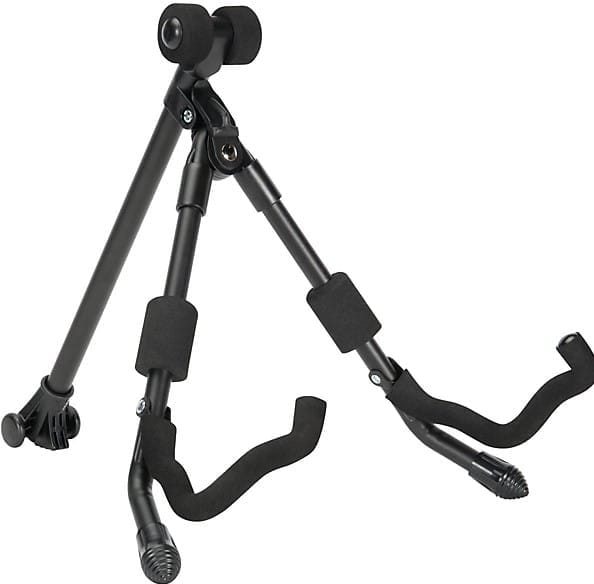
Guitar stands come in various styles and materials to accommodate different guitars. Acoustic guitar holders tend to have broad, padded cradles, while bass guitar stands often feature adjustable guitar neck supports.
Some stands are collapsible, making them highly portable and ideal for music lovers on the move. They can be easily folded down and stowed away when not in use, making them a practical choice for gigs, rehearsals, or even home practice.
A guitar stand serves a dual purpose: protecting a guitar and showcasing it aesthetically pleasingly. A guitar wall mount, also known as a guitar hanger, is designed to securely hang your guitar on a wall for storage and display purposes.
Best Deals are waiting for you!
Score amazing deals on unique guitars at Guitar Center and Musician’s Friend! Both websites are best sellers of cool guitar gadgets, and the best part? Free shipping within the USA on any guitar you choose! So browse their collections and find the perfect instrument to rock out with, knowing you’ll save some cash on delivery. Additionally, these websites are your go-to resources if you’re looking for ukuleles, banjos, and 6-string and 12-string guitars.
Conclusion
Other tools for guitars include a pendant necklace, guitar capo, key chain, guitar pickup, guitar wall hanger, and guitar pick puncher. These unique guitar accessories serve practical purposes and add a touch of personality and flair to a guitar player’s setup. Each accessory brings its unique charm to the table.
So, whether you’re a seasoned virtuoso or a beginner, don’t hesitate to explore the world of guitar gadgets. They might be the missing piece that elevates your playing to new heights.
FAQ of Unique Guitar Accessories
There are many different types of accessories that you can buy, as we’ve discussed in this article. And though none of these except for guitar strings are essential for a guitarist, they are all useful in their way, and none of them will be a waste of your money.
If you want to personalize and add character to your instrument, there are numerous creative options to consider. They can range from simple DIY projects to more elaborate customizations.
The easiest way would be to apply vinyl decals or stickers to the body or pickguard of the guitar. Some other options will be to paint or airbrush artwork, or to swap out stock parts like the inlays, bindings knobs, switches, and pickguards for custom ones.
There are many reasons that a guitarist might want to collect many guitars. One is that different guitars produce different sounds.
An electric guitar plays and sounds differently from a classical guitar, for example. Another may be that the players like to use multiple different tunings on the same guitar.
A fret wrap, also known as a string dampener or fret mute, is essentially a band or strip of material placed around the neck of the guitar, just above the frets. It’s a tool used by guitarists to control unwanted string noise and overtones.
These unique guitar accessories are particularly useful for controlling extraneous noise that can occur when playing techniques like tapping, slapping, or even aggressive strumming.
Yes. Unless you put it in a place like the fretboard or use it to obstruct the soundhole, a sticker won’t affect the sound of a guitar in any meaningful way.
- 6 Unique Guitar Picks That Will Blow Your Mind - February 6, 2025
- Master the Harmonic Major Scale And Intervals - February 6, 2025
- 9 Eye Catchy Unique Guitar Straps for Every Musician - February 6, 2025




